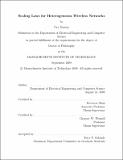Scaling Laws for Heterogeneous Wireless Networks
Author(s)
Niesen, Urs
Downloadmain_3.pdf (1.066Mb)
Metadata
Show full item recordAbstract
This thesis studies the problem of determining achievable rates in heterogeneous wireless
networks. We analyze the impact of location, traffic, and service heterogeneity.
Consider a wireless network with n nodes located in a square area of size n communicating
with each other over Gaussian fading channels. Location heterogeneity is
modeled by allowing the nodes in the wireless network to be deployed in an arbitrary
manner on the square area instead of the usual random uniform node placement. For
traffic heterogeneity, we analyze the n × n dimensional unicast capacity region. For
service heterogeneity, we consider the impact of multicasting and caching. This gives
rise to the n × 2n dimensional multicast capacity region and the 2n × n dimensional
caching capacity region. In each of these cases, we obtain an explicit informationtheoretic
characterization of the scaling of achievable rates by providing a converse
and a matching (in the scaling sense) communication architecture.
Description
Thesis Supervisor: Devavrat Shah
Title: Associate Professor
Thesis Supervisor: Gregory W. Wornell
Title: Professor
Date issued
2009-09-15Series/Report no.
Technical Report (Massachusetts Institute of Technology, Research Laboratory of Electronics);729